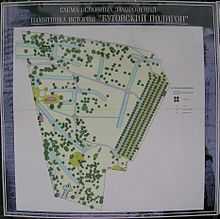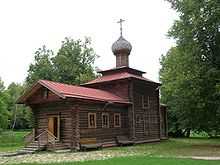Butovo firing range
Coordinates: 55°32′00″N 37°35′39″E / 55.53333°N 37.59417°E

The Butovo firing range (Russian: Бутовский полигон) is the name of a location where more than 20,000 political prisoners were shot during the Great Terror of the Soviet Union and thereafter from 1938 to 1953. It is located in the Yuzhnoye Butovo District of Moscow, near the village of Drozhzhino (Russian: Дрожжино). Among those killed in Butovo were Béla Kun, Gustav Klutsis, Seraphim Chichagov, and a number of Orthodox priests later canonized as the New Martyrs. The Russian Orthodox Church took over the ownership of the lot in 1995 and had a large Russian Revival memorial church erected there. The mass grave may be visited on weekends.
History
Until the 19th century, the site was occupied by a small settlement by the name of Kosmodemyanskoye Drozhino, first attested in 1568 as owned by a local boyar Fyodor Drozhin. The estate's owner in 1889 was certain N.M. Solovov, who turned it into a large stud farm and had a large hippodrome built there. His descendant, I.I. Zimin donated the stud farm to the state in the aftermath of the Bolshevist Revolution in exchange for right to flee the country. The farm became the property of the Red Army.[1]
In the 1920s, the site, now officially named Butovo, was ceded to the infamous OGPU. In 1935 it was turned into a small firing range for the NKVD. The remaining grounds of the former farm were occupied by a sovkhoz Kommunarka and a dacha of Genrikh Yagoda. During the Great Purges the cemeteries of nearby Moscow could not cope with the number of victims of Soviet terror. Because of that, in late 1936 both the firing range and the nearby sovkhoz Kommunarka were turned into a Special Object, or a secret mass murder site operated by the NKVD.
The exact number of victims executed there remains unknown as only fragmentary data has been declassified by NKVD's successor services.[2] Some sources cite between 10 and 14 thousand people murdered at Kommunarka and additional 20,765 at Butovo,[3] the latter number includes only those executed between August 1, 1937 and October 19, 1938.[2] Reportedly the most busy day at the firing range was February 28, 1938 when 562 people were executed on the same day.[3] The site remained heavily guarded by Soviet and later Russian secret police until 1995, when it was sold to Russian Orthodox Church.

Among those killed and buried at Butovo were Soviet military commander Hayk Bzhishkyan, Russian statesman Vladimir Dzhunkovsky, Russian Bolshevik revolutionary and politician Nikolai Krylenko, former leader of Hungary Béla Kun, Latvian painter Aleksandr Drevin, Latvian film actress Marija Leiko, bishop Seraphim Chichagov, Prince Dmitry Shakhovskoy, Latvian photographer Gustav Klutsis, and over 250 leading cadres of the German Communist Party (KPD), for example Hermann Taubenberger and Walter Haenisch, with the explicit approval of party leaders Wilhelm Pieck and Walter Ulbricht, and partly blackmailed to the NKWD by Herbert Wehner, who at this time was still a member of the German KP Politburo.
See also
References
- ↑ Л. Головкова, Спецобъект «Бутовский полигон» (история, документы, воспоминания)
- ↑ 2.0 2.1 Бутовский полигон. 1937—1938. Книга памяти жертв политических репрессий (in Russian) 1–7. Moscow: Memorial. 1997–2003.
- ↑ 3.0 3.1 Vladimir Kuzmin (31 October 2007). Поминальная молитва; Владимир Путин посетил Бутовский полигон, где похоронены жертвы массовых расстрелов. Rossiyskaya Gazeta (in Russian) (4506). Retrieved 2011-10-18.
References
- Сайт Храма Святых новомучеников и исповедников Российских в Бутове - обширная информация о Бутовском полигоне, людях пострадавших на нем, деятельности общины храма, памятных и иных мероприятиях
- Сайт Бутовский полигон — Русская голгофа
- Региональное общественное движение «В защиту жертв политрепрессий, законных прав реабилитированных граждан» Мемориа-Память 14.03.2008
- Бутовский полигон — Русская Голгофа. Протоиерей Кирилл Каледа. 12.022007
- В. Н. Сачков. «КОГО РАССТРЕЛЯЛИ НА БУТОВСКОМ ПОЛИГОНЕ» — редуцированная обобщающая статистика по лицам, казнённым на Бутовском полигоне в 1937—1938 гг.
- ПРОЕКТ МЕМОРИАЛЬНОГО ЦЕНТРА "БУТОВО" при Храме Новомучеников и Исповедников Российских на Бутовском полигоне
- Бутовский полигон: археология расстрелов
- Former Killing Ground Becomes Shrine to Stalin’s Victims
| Wikimedia Commons has media related to Butovo firing range. |